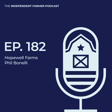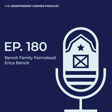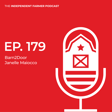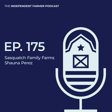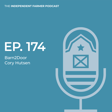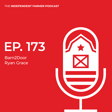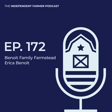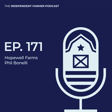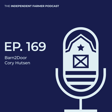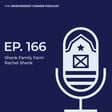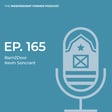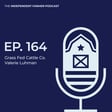Become a Creator today!Start creating today - Share your story with the world!
Start for free
00:00:00
00:00:01

Seamless Farm Sales with Combined Inventory
In this week's episode, James and Anthony discuss Barn2Door's most recent feature (set to release in the coming weeks): Combined Inventory. Your Farm store will have the ability to offer a single item --- regardless of price(s), unit size(s) and / or price sheet (retail, private or wholesale).
Learn more: https://www.barn2door.com/blog-all/combined-inventory
Find more Farm resources: https://www.barn2door.com/resources
Transcript
Introduction to the Independent Farmer Podcast
00:00:10
Speaker
Hello and welcome to the Independent Farmer Podcast, the go-to podcast for do-it-yourself farmers who are taking control of their own business, skipping the middleman, and selling direct to local consumer and wholesale buyers. This podcast is hosted by Barn to Door, the number one business tool for independent farmers to manage their business, promote their brand, and sell online and in person. Let's dive in to today's Independent Farmer Podcast.
Importance of Combined Inventory for Farmers
00:00:43
Speaker
Welcome to the independent farmer podcast. I'm James, the COO at Barnadore, and your host for today's episode. As many of our listeners may be aware, Barnadore offers an all-in-one business solution for independent farmers who are cutting out the middleman and taking control of their business, selling under their brand, and making sure their customers can purchase from their farm online and in person.
00:01:06
Speaker
In today's conversation, we're going to be diving into our newest release, Combined Inventory. This is a long awaited release that is really exciting. And today I'm happy to welcome back Anthony, who is our Senior Product Manager and has worked alongside our engineers to develop this highly anticipated feature release of Combined Inventory. Today I'm going to be diving in with Anthony to talk more about some of the features and capabilities that Combined Inventory has to offer to help you streamline your inventory management and save time. Welcome back, Anthony. It's great to see you. and Great to be back. Thank you for having me, James.
Anthony's Journey and Role at Barnadore
00:01:43
Speaker
Well, hey, before we start diving into the feature release, because I know this is, again, a big deal for farmers and big deal for our product and engineering team as well, why don't we share with our listeners who may not know you a little bit more about your background. You've been under door for how many years and how did your career evolve here?
00:02:00
Speaker
Yeah, just cracked four and a half years with the company. And yeah, it's certainly ah been really great getting to see all all the growth. I started out as an onboarding manager here, so had the chance to work with several hundred farmers of all types, getting to kind of see and and hear their different experiences and help them get set up on the barn to door platform. Did that for several years and then took the step over into the product world and then also work pretty closely with our support team.
00:02:29
Speaker
Wow, so you've seen a lot of different sides to this business.
COVID-19 Challenges and Transition
00:02:33
Speaker
Obviously, I remember when you first started, you started the height of the COVID craze, if I recall correctly. And you guys were working some pretty crazy hours helping farmers get online.
00:02:43
Speaker
Yeah, there was certainly a lot going on with farmers markets, kind of a lot of uncertainty there, some close some in different formats. So yeah, as you mentioned, quite, quite a few sets of long hours, but you know, well appreciated and definitely great to lean in during that period. But yeah, and even kind of after that whole time, even getting to kind of work with farms as we kind of have returned to normalcy, it's been a ah wonderful transition.
00:03:10
Speaker
Well, now you sit in a very unique ah position inside the business because you run both product and support. And you've also had an opportunity to, like you said, onboard hundreds of farmers. So I know you've just talked to people all across the country from all kinds of different backgrounds, right?
Development of Combined Inventory Feature
00:03:27
Speaker
Now this feature release, combined inventories, been a big deal. I know it's been in the works for more than two years.
00:03:35
Speaker
Why don't you share a little bit more about the Genesis and before we get into the details about how this came about? Because I'm sure both as an onboarding manager and certainly in your role in the product, you've heard a lot of requests for this kind of capability. Tell me a little bit more about the planning process and the Genesis for the idea.
00:03:51
Speaker
So this has been one of our probably oldest and most requested features. Ultimately, combined inventory stems from farmers looking to maintain an accurate inventory number, which you know can be quite the challenge. We help farmers who Some of them have perishable inventory, some of them have a little bit more certainty in what's in the freezer, but ultimately trying to help folks make sure that what they're presenting to their customers is accurate so that they don't need to go back and have a conversation about, you know, hey, this was listed on the storefront, but we actually don't have it in stock. Or maybe if you want to wait to get it to later.
00:04:31
Speaker
trying to help avoid those sort of sort of conversations and to really remove any friction of that kind from the conversation with their customers. So combined inventory is an opportunity to address that, especially for a couple of the key use cases, what we'll get add into here in a bit.
Unique Aspects of Selling Farm Products
00:04:50
Speaker
Now, I know one of the things that's unique about Barnadora is that we've built our product for farmers. right so Farm products are quite different right versus you know just like selling t-shirts with a standard e-commerce website. so Maybe you can talk a little bit about some of the nuances you had to think about right because one of the things with combined inventory, from what I understand, is that you're talking about could be the same product that are just simply three different sizes versus three different buckets of t-shirts that are actually truly three distinct sets of inventory, correct? Yeah. And to kind of start to unpack this, so with combined inventory, we're going to be sorting the ability to sell and that same inventory quantity in many unit sizes. So like in the case you're mentioning on kind of a standard e-commerce platform where you have different
00:05:42
Speaker
colors or sizes of t-shirts. You only have three large red t-shirts with your logo on it or something like that. That's a very easy number to keep track of and likewise you might have four mediums and two smalls and those numbers never cross or touch.
00:05:59
Speaker
so That's the simple case that the e-commerce world is used to dealing with. In our space, we have farmers that are listing many unit sizes that are related to one another. so That's pretty common across a lot of different segments, but especially with a lot of ranches that we work with, but also with produce farms, dairies, and yeah a couple of other cases. Yeah. Some really nuanced use cases, like you said, because for oftentimes are interchangeable like you said, but just different uni sizes. So let's dive in. Let's talk a little bit more about combined inventory as a feature itself. So can you give the listeners just a better understanding of like, what is combined inventory specifically? And again, how is it different or why is it so important for farmers when they're managing the vessels?
00:06:51
Speaker
Sure thing. So combined inventory is the ability to take your single inventory item and to list it now with two additional dimensions. So the first one is to list it in many unit sizes. So for the case of a ranch really quickly, and we'll unpack this a little more, but they would want to list their bulk beef in or on the hoof in both a quarter, half and whole.
00:07:21
Speaker
So all three of those unit sizes draw from the number of animals that they're taking to the butcher. And if one customer buys a quarter, another customer buys a quarter that makes one half or half of whole. So the second dimension is the ability to list across many pricing sheets. So for many of our farms, they maintain both a public facing store and also a wholesale pricing sheet or perhaps some other accounts that we work with maintain a private pricing sheet, whether they use that for their CSA members or close friends or family, what have you. Combined inventory now allows for a farmer to take you know the same dozen eggs that are being listed on their retail storefront.
00:08:08
Speaker
you know, maybe at a premium price and to turn around and being ah able to offer that to their wholesale customers or their family members at a discount while still drawing from that same inventory quantities. One sale in one place draws down from the same number of eggs that you have in your fridge as if it were purchased by another customer.
00:08:30
Speaker
That's a big deal. So now farmers can sell a product in multiple sizes across multiple price points, yet it will all deduct from the same bid, right? So, and yeah that's going to be a huge time-saver for farmers, right? Because I imagine today, how are farmers handling this today? Are they just doing pen and pencil spreadsheets or having to go through and update things online? I mean, I imagine it's going to be really difficult for farmers today.
Addressing Inventory Management Difficulties
00:08:56
Speaker
Yeah, and this comes back to kind of that inventory accuracy point I was touching on earlier, where many farms today, if they, for instance, want to list across many pricing sheets, like for their retail public storefront and their wholesale customers,
00:09:12
Speaker
you know Let's say they had 100 dozen eggs. Right now, they would have to either choose, hey, do I list 100 in both places and potentially oversell? Or do I somehow divvy this up and say, oh, there's 50 in my public store and 50 for my wholesale people? But realistically, if you have your best wholesale account come across who wants to raise their hand and buy 60, you don't want them walking away with broken expectations. so That was a question that came up quite a bit when I was over in the onboarding side was how to handle these kind of overlaps and cases. And yeah, this new functionality will allow for farmers to be able to list across these different dimensions and to have inventory drawn down in a way that is first and foremost accurate and make sure that customers are being shown the appropriate options. That is absolutely huge. I can't imagine how much
00:10:08
Speaker
time this is going to save farmers. And to your point, make buyers happy too. Like you said at the very beginning, like no one wants to purchase something and then have the farmer call them and say, hey, you know what?
00:10:19
Speaker
I'm going to have to refund you that money that you already paid me because that product is actually no longer available. That's going to go away. This is now going to make it where you're going to have consistent inventory regardless if it's a retail or wholesale or private. Let me ask you, does this also work for online and offline transactions? If they're selling at the farmer's market with their point of sale, will that also work in this use case as well?
00:10:44
Speaker
Yep. And ultimately that's one of the things that we do ah set ourselves apart as Barnadore is first off the connection between the inventory accounts for in-person versus online sales. That is something that we've prioritized since the very first day that we released Point of Sale and that is maintained with this feature. So the ability to sell across many pricing sheets and many unit sizes, just as people might see in their online store.
00:11:14
Speaker
is the same experience at the point sale. So no further action or setup needed just works out of the box. Wow, that is absolutely huge. This is like a enterprise grade solution.
00:11:27
Speaker
right but available for small business e-commerce i'm not aware of it any solution in the market designed for small businesses that offers this type of capabilities. Really well done. Let's dive in some examples for our listeners so we can just illustrate for them some perhaps use cases that they might be able to relate to. The first example you mentioned was selling on the huff. Walk me through that. so If I'm a farmer who's got a big livestock operation and I'm selling cattle direct to market, primarily selling let's say quarter, half, and whole, how is this going to apply to me? and
00:12:00
Speaker
Yeah, so for many of the ranches that we support with that are trying to sell kind of portions of a whole beef, they often, you know, early in the process, it's simple enough, right? You know, you can tell a bunch of quarters have holes, but especially when it gets down to the last few animals, you start running into a couple little snarls if you didn't have this system in place.
00:12:25
Speaker
where let's say you get down to the last two animals and the question is, you know, are you listing two holes, four halves and eight quarters and and bear with me a little bit on the numbers here, but, or are you divvying that up similar to kind of the pricing sheet example I was giving before? Do you, are you listing like one hole, one half and two quarters?
Practical Applications for Ranches and Farms
00:12:47
Speaker
The issue there is that either, again, in that first case, if you're listing everything at all sizes, you're quite possibly going to oversell and going to have to go and have a uncomfortable conversation with the buyer about delaying or refunding or something like that. Or you risk not showing the full suite of options to a customer because, you know, if you're listing one whole one half and two quarters, someone comes in and buys the half.
00:13:13
Speaker
in theory before this combined inventory feature. Now all that would be left in your storefront is two quarters and a whole, which, you know, obviously leaves a gap there in the middle. And, you know, what if another customer comes along before you've had the chance to kind of mess around with your inventory numbers.
00:13:31
Speaker
who wants a half and they don't see that option there and you very well could lose that customer. So now in this combined inventory world, you have the ability to have all those different quantities talk to one another. So you list a total of two holes and if someone buys a half, you now have one and a half holes remaining and all three options are going to continue to show to the buyer. So you'd still have effectively six quarters, three halves and one hole.
00:14:01
Speaker
you know, you go even further than that. Let's say you sell a couple more quarters. You've got three quarters of a cow remaining. The system is going to be smart enough to show them three quarters, one half and no holes available, right? It's counting from just what can be made out of that three quarters of a cow that is remaining. So, wow, really special stuff. And again, a conversation I got to have so many times with ranchers trying to figure out, especially when they're trying to juggle different processing dates, how to make sure that they're juggling this and making it very clear for their buyers. This is a huge, huge step to making sure that interaction just goes that much more smoothly. Wow, this is absolutely huge. I can understand why ranchers would be so enthusiastic about this. No reconciliation needed, no disappointed buyers, keep all the money in your pocket.
00:14:54
Speaker
automatically keep, like you said, inventory accurate up to date on the website without them having to make any changes manually. And it just automatically calculates whatever the remaining units are, right? That's pretty impressive. Talk to me about units. Like what if I sell in different types of unit sizes, right? Let's maybe shift gears to talk about produce, right? Produce, you know, sometimes people sell by the pound. Other people sell by the handful, the basket, the crate, whatever.
00:15:21
Speaker
how do you make combined inventory work for? Let's say I've got an Apple farm. How does that work? It's a great question. So as far as going through and managing combined inventory for produce, farmers will have the option to set any base unit size that they'd like to track in. So if they want to keep it by the pound or by the piece, they can do so. So like even in the case of maybe you sell apples in different packs, like there's a orchard I worked with that sold in the Chet Kenilow three pound bags or a five pound box or 20 and I think even a 40 pound box you would be able to say hey I have a thousand pounds of apples and have all those different unit sizes listed and it would draw down
00:16:04
Speaker
appropriately. So exactly to say that if someone bought a 20 pound box, someone else bought two five pound boxes, someone bought a couple sex, three pounds, all those are drawing from that same thousand pounds of apples that you have available. So ultimately this feature spans across different segments and we anticipate it'll be well enjoyed by the produce farms that we support as as well as the ranches. That's absolutely huge. So they can go in, define what the sizes are, like you said, bag, box, or crate,
00:16:41
Speaker
And then they can also then define like how many pounds that represents right from a base unit size standpoint. And then it'll just do the math automatically. So a crate might be different to me than it is to another produce farm. Or a bag might be different, might weigh different. Obviously very big difference between the weight of apples versus perhaps the weight of spring onions. right So love this idea that the produce farm can just go in and customize it for how they sell their product.
00:17:08
Speaker
That's pretty unique. Let's shift over to talk a little bit about poultry farms too, because I know this was a key use case given how many poultry farms you produce a lot of eggs. Talk to me through that use case and why this is such a special feature set for poultry farmers.
00:17:25
Speaker
Certainly, and this especially was a strong use case that we considered as we were designing the functionality where, especially across the different pricing sheets, a lot of the ag producers that we work with do have quite the range of customers that are purchasing their products.
00:17:43
Speaker
and quite obviously have them listed in different unit sizes, right? You have, you know, a base dozen, but you've got half dozen little crates. You've got 18 counts flats, even kind of larger, more commercial flats if you want to go so far. But depending on how you package it, it can be a different count. But it fundamentally, you know, there's always a certain number of eggs. And if the the farmer wants to say, hey, I want to sell it by the dozen to my retail customers.
00:18:11
Speaker
they would be able to sell it exactly as so, one dozen count. Or if they, let's say, are selling it in an 18 count to their wholesale, they would be able to sell effectively one and a half dozen units at a different price point to that wholesale customer as well. So the ability to take the same inventory and list it across many unit sizes and many pricing sheets was integral to the design here. Like I said, that the egg case that we're highlighting was certainly top of mind. Wow. That's a big deal because if I've got layers that are producing 500 or 1000 eggs a day, that's a lot of dozens of eggs, right? So to your point, selling by the dozen or by the case or a large case
00:18:57
Speaker
you know to be very different and to take a lot of if they had to go through and mainly reconcile that. Now they just have one spot. Their wholesale customers can buy those big 15, 18, 30 dozen cases and just all deduct automatically. Boy, that's a huge time savings for them as well. So these are all products that pretty obvious, I think, in terms of like, hey, you buy an apple, you buy an egg, it's a very fixed size. Walk me through a use case, for instance, where perhaps you're dealing with something that is packaged like dairy right because dairy could be sold in a variety different
00:19:32
Speaker
How would a dairy farmer use this? So for the dairy farmers that we support, there's definitely a good use case here as well. Fundamentally, it comes down to and what your production cycle looks like. So dairy farmers, similar to the egg farmers, as mentioned, will absolutely get the benefit of the different pricing sheets because many of them have a wholesale contract or several in addition to what they're selling to their day to day customers. Beyond that, of course, many dairy products like milk or buttermilk or go through the whole list are sold in a variety of unit sizes spanning from gallon to half gallon quart pint go on down the list.
00:20:16
Speaker
So ultimately, the point of interest here is you know A, further simplifying the interface for customers, and B, making sure, again, we have that accurate inventory drawdown. So for dairies, because they have such a quick production cycle, they can say, hey, I make approximately 100 gallons a day or something along those lines.
00:20:39
Speaker
and would be able to list that and then have it draw down appropriately listing those same hundred gallons by the gallon, the half gallon, the quart, pine as minute of a quantity or unit sizes they would like. So certainly again, a case that we were considering. Well, that's awesome. I imagine a lot of these dairy farmers are going to love this feature too, just again, back to time savings and making that buyer experience just easy,
Enhanced Buyer Experience
00:21:06
Speaker
right? So tell me a little bit about the buyer experience? When the buyer is checking out and they go to a farmer's store that they have, what are they going to see? Are they going to see all those unit sizes available as an option for that milk that they
00:21:19
Speaker
Yep, ah exactly that. So formerly the structure that many of the farms that we have the p pleasure of supporting had to employ was listing each unit size as a separate item on their storefront. So while it might be simple enough for some of the ranches that we support, they list a quarter, half, and a whole three items is pretty manageable.
00:21:43
Speaker
in the case of the dairy where they have all these different unit sizes, gallon, half gallon, quart pint, etc. plus different grades of milk and across many pricing sheets. There are a lot of items on some of those storefronts to the point that you know some sellers might not even choose to list everything.
00:22:04
Speaker
which of course we want to make sure that their buyers are kind of seeing the full slate of what's available to them. So in the new interface, effectively, the customer would be able to see a whole milk item. And when they click into it, they will see the different unit sizes clearly laid out to choose from a very common kind of layout to what they would experience elsewhere online very clean and they can go ahead and choose whether they would want a gallon or half gallon or a pint and they can even choose multiple if they want a gallon and a pint or something along those lines and have all those in their cart at the same time so ultimately the buyer interface is much cleaned up for the farmer to be able to list all the options without cluttering their storefront.
00:22:51
Speaker
Wow, that's going to make it a much cleaner buyer experience, just like you said. And I'm sure it will also just aid in contributing to increased conversion, more money for farmers in their pockets. And what I like is the simpler purchase experience for the buyer. right This is a really big deal, presenting them with all those options. Well, let's shift gears to talk about maybe a use case where combined inventory may not work. There's some challenges with combined inventory.
00:23:17
Speaker
What other types of farms should consider where this may not be a good fit?
Limitations of Combined Inventory
00:23:23
Speaker
So a couple of cases that kind of are top of mind here. So key to note that combined inventory is for products that draw down from a single inventory quantity. So in the cases that we've been listing, quarter, half, and whole cow all draw from the same animal. Whereas some other cases, particularly in the realm of kind of more sealed pantry type products,
00:23:50
Speaker
I'm kind of thinking about honey and maple syrup. We get a chance to support a number of those type of farms. They're not about to be breaking the seal on their gallons and pouring it out further into their little maple leaf courts or something like that once that product's been packaged up. So because they have a set number of gallons and a set number of quartz in every single unit size whether it's a little maple leaf or a honey bear or something like that because those are discrete counts even though there are different unit sizes of quote the same product those would continue to be listed as separate unit sizes on the storefront. I will note that they still do get the benefit too of listing them across many pricing sheets so if you do have your gallon of maple syrup you
00:24:40
Speaker
do have still the benefit of being able to list that at different price points for retail wholesale and and private customers and that would all still draw from the same quantity. So more of a ah limited application and in some cases like that.
00:24:54
Speaker
but Yeah, I think that's a great example though, because like if you're syrup or honey, you probably do sell one gallon, two gallon, four gallon crates, similar to milk, right? And like you said, in both retail and wholesale. So it would apply in that use case. It's just where you're trying to interchange very distinct unit sizes where they're pre sealed, like you said, the little small cord, the ability versus the large one gallon jug, right? You're not going to pour those out, vice versa. So that makes total sense.
00:25:21
Speaker
Well, before we wrap things up, so first off, I just want to say congratulations to you and the engineering team at Barnard Door for all the hard work that went into building, defining, and working through all the edge cases that this product release addresses now. And thanks to all the farmers who are listening who gave Anthony and our engineering team feedback, right? Because they're so critical. We don't just come up with these ideas in a vacuum. I know you talk with a lot of So thank you for taking the time to hear their feedback. But before we sign off, is there anything else you want to share with our farmers about not only this release or maybe be you know what's to come in terms of how this is going to continue to evolve for farmers as they look ahead and working with farmers?
Future Developments and Thanks to Farmers
00:26:05
Speaker
Yeah. I mean, briefly you mentioned that in terms of feedback and kind of where we continue to move with our product development, it is absolutely led by the farmers that we work with and are, you were kind of giving a quick shout out to our engineering team, but also a bit of appreciation is due to our success and support teams as well. They are very meticulous about making sure to document the feedback from the different firms that we work with.
00:26:31
Speaker
And every single one of those requests is manually reviewed and you know appropriately cataloged, documented to make sure that that we're staying aligned with. what farmers are looking for and and delivering value. And that's what leads to new features and functionality like this. As far as kind of more stuff to come, I guess I'll kind of say tongue in cheek a little bit that, you know, looking ahead to spring, we're always kind of keeping an eye towards next season. We get to operate in longer timeframes in the product world. This particular piece of development took several years to develop.
00:27:06
Speaker
And yeah, we have quite a few wonderful new features in the queue and even as follow-ons and allowing a little bit more bulk management of some of the inventory coming and not too, too long. So keep your eyes peeled for that. And yeah, beyond that, we definitely have a lot of plans in the coming months heading into next year. Well, Anthony, I just really appreciate again, all the hard work by yourself and the entire product team, engineering team, et cetera, to do this. I know there was a large body of
00:27:36
Speaker
right so really exciting me to see how this is going to unlock the opportunity for you guys to continue to drive fantastic innovations built specifically for farmers. So thank you.
Conclusion and Resources
00:27:47
Speaker
To all of our listeners, thank you again for tuning in this week to the Independent Farmer podcast. At Barnadore, we are humbled to support thousands of independent farmers across the country and delighted to offer services and tools to help farmers access more customers, increase sales, and save time for their business. If you're an independent farmer who's just getting started or transitioning to selling direct, or if you've been at it for a while and want to simplify your business management,
00:28:13
Speaker
please visit barnadore dot.com backslash learn more. There you can find a lot of details about what we can do now. Thank you for tuning in today and we look forward to joining you next time on the Independent Farmer podcast.
00:28:37
Speaker
Thank you for joining us on the Independent Farmer Podcast. At Barn to Door, we are passionate about empowering independent farmers to build a thriving business. To all the farmers out there, thank you for all you do to grow amazing food, care for the soil, and serve your local communities. You are the backbone of our country. For free farm resources or to listen to prior podcasts, go to barntodoor dot.com backslash resources. We hope you join us again and subscribe to the Independent Farmer Podcast wherever you stream your podcasts. Until next time.
